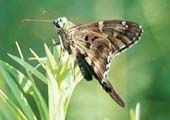Native Plants
Search for native plants by scientific name, common name or family. If you are not sure what you are looking for, try the Combination Search or our Recommended Species lists.
Senegalia berlandieri
Senegalia berlandieri Britton & Rose
Guajillo, Berlandier Acacia, Berlandier's Acacia, Round-flowered Catclaw, Roundflower Catclaw, Mimosa Catclaw, Thornless Catclaw, Huajilla
Fabaceae (Pea Family)
Synonym(s): Acacia berlandieri
USDA Symbol: SEBE2
USDA Native Status: L48 (N)
Senegalia berlandieri is a spreading shrub with many stems from the base, growing 3-15 feet tall. The white-to-cream-colored flowers (yellowing with age), grow in ball-like clusters, 5/8 inch or more in diameter, and are quite fragrant. They have 50-100 or more stamens, but no petals. The pinnately compound leaves are delicate, almost fernlike, 4-6 inches long with 5-9 (sometimes up to 18) pairs of leaflets, and these leaflets are again divided into 30-50 leaflets. The flower is a source of heavy, light-colored honey, rated by many as the best in the state. The seed pods are 3-5 inches long and 1 inch or more wide.
Plant Characteristics
Duration: PerennialHabit: Tree
Root Type: Tap
Leaf Retention: Deciduous
Leaf Arrangement: Alternate
Leaf Complexity: Bipinnate
Leaf Shape: Elliptic
Breeding System: Flowers Bisexual
Fruit Type: Legume
Size Notes: Up to about 15 feet tall.
Flower: Flowers in 1/2 inch globes.
Fruit: Brown 3-5 in.
Bloom Information
Bloom Color: WhiteBloom Time: Feb , Mar , Apr , May
Distribution
USA: TXNative Distribution: Southern part of Edwards Plateau in Texas south through northeastern Mexico to Hidalgo
Native Habitat: Hillsides, Slopes
Growing Conditions
Water Use: LowLight Requirement: Sun , Part Shade
Soil Moisture: Dry
Soil Description: Gravelly, Caliche type, Sandy, Sandy Loam, Medium Loam, Clay Loam, Clay, Limestone-based
Conditions Comments: Senegalia berlandieri is a spreading shrub with many stems from the base. The white-to-cream-colored flowers (yellowing with age), grow in ball-like clusters and are quite fragrant. The pinnately compound leaves are delicate, almost fernlike. The flower is a source of heavy, light-colored honey, rated by many as the best in the state.
Benefit
Use Ornamental: Showy, Aromatic, Attractive, Blooms ornamentalUse Wildlife: Nectar-bees, Nectar-insects, Fruit-birds, Fruit-mammals, Fruit-rodents, Cover.
Conspicuous Flowers: yes
Fragrant Flowers: yes
Attracts: Birds , Butterflies
Larval Host: Long-tailed Skipper Urbanus proteus, Reakirt's Blue Echinargus isola
Butterflies and Moths of North America (BAMONA)
|
Long-tailed Skipper (Urbanus proteus)  Larval Host |
Propagation
Propagation Material: SeedsFrom the National Organizations Directory
According to the species list provided by Affiliate Organizations, this plant is on display at the following locations:Texas Discovery Gardens - Dallas, TX
Texas Parks and Wildlife Department - Austin, TX
National Butterfly Center - Mission, TX
Bibliography
Bibref 1186 - Field Guide to Moths of Eastern North America (2005) Covell, C.V., Jr.Bibref 1185 - Field Guide to Western Butterflies (Peterson Field Guides) (1999) Opler, P.A. and A.B. Wright
Bibref 318 - Native Texas Plants: Landscaping Region by Region (2002) Wasowski, S. & A. Wasowski
Bibref 248 - Texas Wildflowers: A Field Guide (1984) Loughmiller, C. & L. Loughmiller
Bibref 291 - Texas Wildscapes: Gardening for Wildlife (1999) Damude, N. & K.C. Bender
Bibref 297 - Trees of Central Texas (1984) Vines, Robert A.
Search More Titles in Bibliography
Web Reference
Webref 23 - Southwest Environmental Information Network (2009) SEINet - Arizona ChapterWebref 1 - Texas Native Shrubs (2002) Texas A&M University Agriculture Program and Leslie Finical, Dallas Arboretum
Additional resources
USDA: Find Senegalia berlandieri in USDA PlantsFNA: Find Senegalia berlandieri in the Flora of North America (if available)
Google: Search Google for Senegalia berlandieri
Metadata
Record Modified: 2022-10-21Research By: TWC Staff